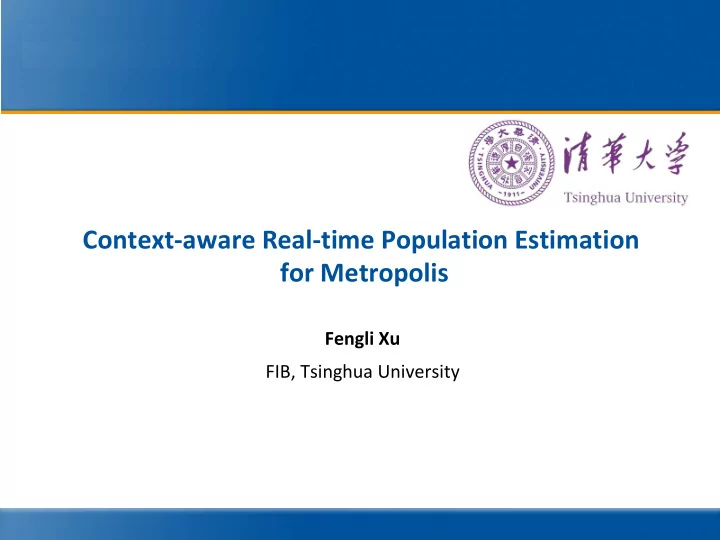

Context-aware Real-time Population Estimation for Metropolis Fengli Xu FIB, Tsinghua University www.1ppt.com
Outline Motivation 1 Material 2 Method 3 Application 4
Motivation Significance 1 Achieving real-time population distribution benefits: n Transportation scheduling 2 n Anomaly detection n Urban planning 3 4 The population distribution varies during the day. Urban citizens are mobile in their daily lives.
Motivation Problems of population census n Very expensive n High latency It’s not feasible to achieve real-time population distribution through census.
Motivation Limitations of previous attempts Call Detail Records 1 1 • Low spatial resolution • High latency(sparse records) 2 Remote Sensing Images 2 3 • Require multiple datasets • Can’t track day-time variation 4 1. Deville, et al. Dynamic population mapping using mobile phone data[J]. PNAS, 2014. 2. Stevens F R, et al. Disaggregating census data for population …[J]. PloS one, 2015.
Motivation Limitations of previous attempts Appropriate datasets Key points to address these problems Advanced method
Material Cellular data access records Device’s ID||Start time||End time||BS ID||Location||Traffic volume Large-scale Long duration Fine-grained From August 1 Start and end time accurate to August 31, to second 2014 9600 BSs 150,000 users Contains 1.96 billion logs, total size over 300GB We extract the number of access of each base station at granularity of one hour.
Material Dataset features Extensive records n Most of users have more than 1,000 records in total. High Sampling Rate n 85% of consecutive records happen in last than 10 Mins. 8.2 hours on average for call records 1 1. Gonzalez M C, et al. Understanding individual human mobility patterns[J]. Nature, 2008.
Material Visualization Mobile users’ behavior is Can we achieve context-aware segmentation 1 related to the type of their of the cities? location(physical context). Different 2 4
Material Context-aware segmentation Road network forms a natural segmentation of 1 urban environment. 1 2 3 4 1. Yuan J, et al. Discovering regions of different functions …,SIGKDD, 2012.
Material Labeling the type of regions POI — a specific point location of a certain function. n Collect POI data though APIs 1 n Extract TF-IDF features n Using kmeans to detect clusters 1. http://map.baidu.com/
Material Ground truth 𝑋𝑝𝑠𝑚𝑒𝑞𝑝𝑞 𝑞𝑠𝑝𝑘𝑓𝑑𝑢 1 : n Only provide night-time population. n Accurate(State of the art). n High resolution 100mX100m. 1. http://www.worldpop.org.uk/.
Material Data fusion Mapping cellular data and worldpop data into segmented regions based on overlapping area.
Method Estimation model n Inspiration: superlinear effect has been discovered in 1 many fields in urban area, which is considered to be the result of intensive cooperation. 1 2 𝜄 . = 𝛽(𝜍 . ) 4 3 ln 𝜄 . = ln 𝛽 + βln 𝜍 . 4 1. Bettencourt L M A. The origins of scaling in cities[J]. science, 2013.
Method Estimation model n Context-aware estimation model. 1 2 𝜄 . = 𝛽 9 (𝜍 . ) 4 : 𝑘 = 1, 2 … 7 3 4 Users’ behavior is spatial heterogeneous.
� � � Method Estimation model 1 n Expand the model into a dynamic one. 4 : 𝑆 A = B 𝜄 . D B 𝛽 9 𝜍 . 2 . A = 𝑆 A ×𝛽 9 𝛽 9 3 A = 𝛽 9 A ) 4 : F . A (𝜍 . 𝜄 A is scaled to model the temporal inhomogeneity of users’ 4 𝛽 9 behavior, while 𝛾 � 𝑘 is fixed to model spatial characteristics.
Method Evaluation method Evaluation datasets • Worldpop dataset. • Transportation dataset(10 million taxi trips, 1 month) 1 . Evaluation schemes • Validate the night-time estimation with Worldpop data. • Evaluate the real-time estimation with transportation dataset. 1. http://soda.datashanghai.gov.cn/.
Method Evaluating night-time estimation 1 2 n Reduce 22.5% estimation error, enhance 12.5% correlation. n Performance gain is most significant in education, scenery and business regions.
Method Evaluating dynamic estimation 1 2 3 n Estimated population has a high correlation with taxi data in central area of urban. 4 n The correlation is significantly higher during day-time.
Method Evaluating dynamic estimation The dynamic estimation matches well with taxi data. n The correlation monotonically increases with taxi density. n Underlying reasons: taxi data can’t capture population well when its density is low.
Application Observing urban dynamics Simple visualization can quantify the phenomenon of morning and evening rush.
Application Observing urban dynamics n Morning rush is more intensive than evening rush. n Different functional regions have distinct population patterns.
Application Locate new subway station 1 n Warmer color represents higher variation of population. 2 n The regions with high population variation and no 3 subway station are recommended identified. 4
Summary •Appropriate data: collect 3G/LTE data access records of over 9,600 BSs with 150,000 subscribers for one month •Advanced method: First estimation model to produce accurate real-time population estimation. •Applications: •Visualizing and quantifying the dynamics of urban population. •Recommending locations for new subway stations.
Thanks you! For Data Sample, Please Contact xfl15@mails.tsinghua.edu.cn liyong07@tsinghua.edu.cn FIB-LAB: http://fi.ee.Tsinghua.edu.cn
Recommend
More recommend